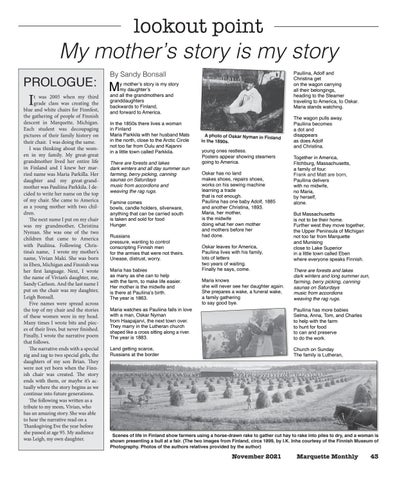lookout point
My mother’s story is my story PROLOGUE:
I
t was 2005 when my third grade class was creating the blue and white chairs for Finnfest, the gathering of people of Finnish descent in Marquette, Michigan. Each student was decoupaging pictures of their family history on their chair. I was doing the same. I was thinking about the women in my family. My great-great grandmother lived her entire life in Finland and I knew her married name was Maria Parkilla. Her daughter and my great-grandmother was Pauliina Parkkila. I decided to write her name on the top of my chair. She came to America as a young mother with two children. The next name I put on my chair was my grandmother, Christina Nyman. She was one of the two children that came to America with Pauliina. Following Christina’s name, I wrote my mother’s name, Vivian Maki. She was born in Eben, Michigan and Finnish was her first language. Next, I wrote the name of Vivian’s daughter, me, Sandy Carlson. And the last name I put on the chair was my daughter, Leigh Bonsall. Five names were spread across the top of my chair and the stories of these women were in my head. Many times I wrote bits and pieces of their lives, but never finished. Finally, I wrote the narrative poem that follows. The narrative ends with a special zig and zag to two special girls, the daughters of my son Brian. They were not yet born when the Finnish chair was created. The story ends with them, or maybe it’s actually where the story begins as we continue into future generations. The following was written as a tribute to my mom, Vivian, who has an amazing story. She was able to hear the narrative read on a Thanksgiving Eve the year before she passed at age 95. My audience was Leigh, my own daughter.
By Sandy Bonsall
Pauliina, Adolf and Christina get on the wagon carrying all their belongings, heading to the Steamer traveling to America, to Oskar. Maria stands watching.
M
y mother’s story is my story my daughter’s and all the grandmothers and granddaughters backwards to Finland, and forward to America. In the 1850s there lives a woman in Finland Maria Parkkila with her husband Mats in the north, close to the Arctic Circle not too far from Oulu and Kajanni in a little town called Parkkila. There are forests and lakes dark winters and all day summer sun farming, berry picking, canning saunas on Saturdays music from accordions and weaving the rag rugs. Famine comes bowls, candle holders, silverware, anything that can be carried south is taken and sold for food Hunger. Russians pressure, wanting to control conscripting Finnish men for the armies that were not theirs. Unease, distrust, worry. Maria has babies as many as she can to help with the farm, to make life easier. Her mother is the midwife and is there at Pauliina’s birth. The year is 1863. Maria watches as Pauliina falls in love with a man, Oskar Nyman from Haapajarvi, the next town over. They marry in the Lutheran church shaped like a cross sitting along a river. The year is 1883.
A photo of Oskar Nyman in Finl and in the 1890s.
young ones restless. Posters appear showing steamers going to America. Oskar has no land makes shoes, repairs shoes, works on his sewing machine learning a trade that is not enough. Pauliina has one baby Adolf, 1885 and another Christina, 1893. Maria, her mother, is the midwife doing what her own mother and mothers before her had done. Oskar leaves for America, Pauliina lives with his family, lots of letters two years of waiting. Finally he says, come. Maria knows she will never see her daughter again. She prepares a wake, a funeral wake, a family gathering to say good bye.
Land getting scarce, Russians at the border
The wagon pulls away. Pauliina becomes a dot and disappears as does Adolf and Christina. Together in America, Fitchburg, Massachusetts, a family of four. Frank and Matt are born, Pauliina delivers with no midwife, no Maria, by herself, alone. But Massachusetts is not to be their home. Further west they move together, the Upper Peninsula of Michigan not too far from Marquette and Munising close to Lake Superior in a little town called Eben where everyone speaks Finnish. There are forests and lakes dark winters and long summer sun, farming, berry picking, canning saunas on Saturdays music from accordions weaving the rag rugs. Pauliina has more babies Selma, Anna, Tom, and Charles to help with the farm to hunt for food to can and preserve to do the work. Church on Sunday The family is Lutheran,
Scenes of life in Finland show farmers using a horse-drawn rake to gather cut hay to rake into piles to dry, and a woman is shown presenting a bull at a fair. (The two images from Finland, circa 1899, by I.K. Inha courtesy of the Finnish Museum of Photography. Photos of the authors relatives provided by the author)
November 2021
Marquette Monthly
43




















